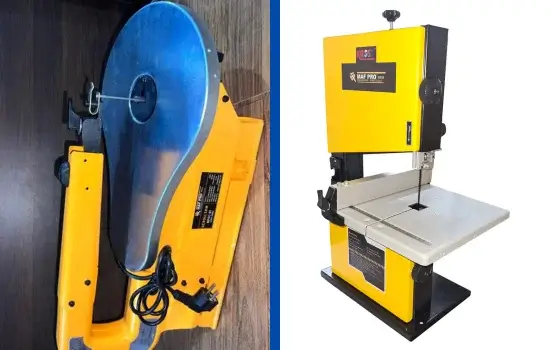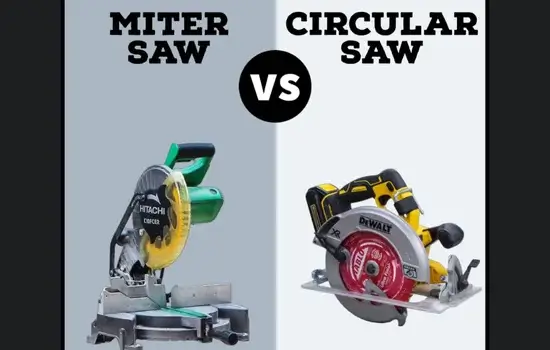For woodworkers, hobbyists, and even metalworkers, having the right saw can make all the difference in the quality and precision of a project. Two of the most popular saws used for intricate cuts and patterns are the scroll saw and the band saw. While both tools are ideal for making detailed cuts, they differ significantly in terms of design, functionality, and best applications.
In this article, we’ll dive into the details of each saw, compare their features, and provide a comprehensive guide to help you determine which tool is best suited for your needs.
Quick Definitions of Scroll Saw and Band Saw
Scroll Saw
A scroll saw is a tabletop saw with a fine, thin blade that moves up and down to create highly detailed cuts. Known for its precision, the scroll saw is ideal for intricate cuts, curves, and interior cuts in wood and other soft materials. The blade is delicate and allows for tight turns, making it perfect for woodworking and craft projects that require finesse.
Band Saw
A band saw, on the other hand, is equipped with a continuous loop blade that moves in a single direction around two wheels. With a wider and more powerful blade, the band saw is ideal for cutting thicker and tougher materials. It’s commonly used for resawing, making straight cuts, and cutting larger pieces, though it can also handle gentle curves.
Key Differences Between Scroll Saw and Band Saw
| Feature | Scroll Saw | Band Saw |
|---|---|---|
| Primary Function | Intricate, detailed cuts | Cutting thicker materials and resawing |
| Blade Motion | Vertical up-and-down motion | Continuous loop in one direction |
| Cutting Direction | Allows for sharp curves and intricate patterns | Primarily straight cuts, gentle curves |
| Material Suitability | Wood, thin metal, plastic, soft materials | Wood, thicker metal, hard plastic |
| Cutting Thickness | Limited to thin materials (typically 2 inches or less) | Can handle thicker materials (4+ inches) |
| Precision | High, ideal for detailed designs | Moderate, best for rough or straight cuts |
| Applications | Woodworking, puzzles, craft, fretwork | Resawing, furniture-making, larger projects |
| Portability | Lightweight, tabletop design | Heavier, often stationary |
| Safety Features | Blade guard, variable speed control | Blade guard, tracking adjustment |
| Cost | Generally more affordable | Can be higher, especially for larger models |
Detailed Comparison of Scroll Saw and Band Saw
1. Purpose and Applications
- Scroll Saw: The scroll saw is a precision tool specifically designed for intricate work. It’s popular among woodworkers who create puzzles, scrollwork, intarsia, and other delicate projects that require tight turns and small cuts. With a scroll saw, users can make interior cuts by drilling a pilot hole, threading the blade through, and then reattaching it. This allows for elaborate cuts within a piece without cutting from the outside, making it an excellent choice for detailed and decorative work.
- Band Saw: Band saws are more versatile when it comes to handling larger pieces and tougher materials. They’re used in woodworking and metalworking for making straight cuts, resawing, and cutting curves, though they are limited to gentler curves compared to a scroll saw. Band saws are ideal for furniture-making, cabinetry, and tasks that require cutting thicker materials with greater power. Their continuous blade allows for efficient cutting without the stopping and starting motion seen in scroll saws.
2. Blade Motion and Cutting Style
- Scroll Saw: The scroll saw’s blade moves in an up-and-down motion. This reciprocating action allows for precise control, making it easy to cut tight curves and intricate shapes. Because of the way it cuts, the scroll saw leaves a smooth finish with minimal need for sanding. Its unique ability to handle delicate patterns and sharp angles makes it highly favored by craftsmen and artists.
- Band Saw: A band saw blade operates in a continuous loop, moving in a single direction around the wheels. This blade configuration is better suited for making longer, continuous cuts, which is ideal for resawing thick materials or ripping wood along the grain. Although it can cut curves, the blade is wider and less flexible than a scroll saw blade, making it less effective for intricate patterns or sharp turns.
3. Cutting Precision and Complexity
- Scroll Saw: Precision is the scroll saw’s forte. It allows for highly detailed cuts, sharp turns, and intricate shapes. Artists and woodworkers frequently use scroll saws for projects where accuracy is essential, such as in fretwork or inlays. With a thin blade, users can make clean and detailed cuts, and many models come with variable speed control to match the blade speed to the material’s hardness and thickness.
- Band Saw: While band saws are precise in their own way, they aren’t suited for highly intricate cuts or tight turns. They excel in making straight cuts, resawing lumber, and producing curved cuts with wider arcs. For users who need precision in cutting large materials, the band saw is excellent, but it’s not ideal for detailed work where minute adjustments are required.
4. Material Suitability and Cutting Capacity
- Scroll Saw: Scroll saws are best for softwood, hardwood, plywood, and occasionally thin sheets of metal or plastic. They’re limited in cutting depth, generally handling materials up to 2 inches thick. Given the blade’s delicacy, thicker or harder materials can wear out the blade quickly or cause breakage. Scroll saws are primarily used on lighter materials and are not designed for heavy-duty tasks.
- Band Saw: Band saws can handle a wide range of materials, including thick wood, hardwoods, metals, and plastics. They’re particularly effective for cutting thicker stock, with cutting capacities typically exceeding 4 inches. This capability makes band saws suitable for heavier tasks, such as cutting large logs into lumber or resawing boards. With the right blade, a band saw can even cut through metal and other tough materials.
5. Portability and Workspace Requirements
- Scroll Saw: Scroll saws are relatively lightweight and compact, designed to sit on a tabletop. This makes them easy to move around, and they don’t take up much space in a workshop. Because of their small size, scroll saws are highly portable and can be used in small workspaces, making them popular among hobbyists and DIYers.
- Band Saw: Band saws, especially floor-standing models, are much larger and heavier than scroll saws. They usually require a dedicated space in a workshop and can be difficult to move once set up. While smaller, benchtop models are available, they’re still bulkier than scroll saws and are typically used as stationary tools.
6. Safety Features
- Scroll Saw: Scroll saws have several safety features, such as blade guards and hold-down feet that secure the material being cut. They’re generally safer to use than band saws due to the slower blade speed and limited cutting depth. Variable speed control also enhances safety, as users can match the speed to the material, reducing the chance of breakage or kickback.
- Band Saw: Band saws are equipped with blade guards and tracking adjustments to prevent the blade from wandering or derailing. Since they are used on larger materials and can cut thicker stock, the potential for injury is higher, especially with kickback or blade drift. Proper safety equipment, such as push sticks and safety glasses, is essential when using a band saw.
7. Cost Considerations
- Scroll Saw: Scroll saws are generally affordable, making them accessible to hobbyists and beginners. Prices can vary based on features like variable speed control, table tilting, and advanced blade clamps, but entry-level scroll saws are generally inexpensive. Higher-end models, with features such as electronic variable speed and robust construction, can be more costly but are still usually cheaper than band saws.
- Band Saw: Band saws can range widely in price, with smaller benchtop models costing less than large, floor-standing versions. Higher-end band saws with larger cutting capacities, resaw capabilities, and premium materials can be quite expensive. Investing in a quality band saw is often worthwhile for professionals or frequent users, as they provide greater durability and cutting power.
Pros and Cons of Scroll Saw and Band Saw
Scroll Saw Pros:
- Excellent for intricate, detailed cuts and sharp curves
- Compact, lightweight, and easy to store
- Relatively safer to use and easier for beginners
- Generally affordable, with budget-friendly options
Scroll Saw Cons:
- Limited to thin materials, not suitable for heavy-duty cutting
- Less versatile than band saws for large projects
- Delicate blade requires careful handling and frequent replacement
Band Saw Pros:
- Can handle thicker materials and tougher cuts
- Versatile for straight cuts, resawing, and gentle curves
- Suitable for both wood and metal with the right blade
- Long blade life compared to scroll saws
Band Saw Cons:
- Larger and more challenging to move, requires more space
- Not ideal for highly intricate or tight curves
- Higher initial investment for quality models
Choosing Between a Scroll Saw and a Band Saw
The choice between a scroll saw and a band saw ultimately depends on your specific needs and project requirements:
- If you’re working on intricate designs, puzzles, or delicate woodwork with tight curves and small cuts, a scroll saw is the best option. Its high precision and ability to make internal cuts make it invaluable for projects that require detail and finesse.
- If you need a tool for cutting thicker materials, resawing, or creating curved cuts with wider radii, a band saw will serve you better. It’s more versatile for large projects, heavy-duty tasks, and is essential for woodworkers and professionals who work with thicker or harder materials.
For some woodworkers, having both tools in the workshop can be beneficial. Each saw has unique strengths that complement the other, ensuring all types of cuts and materials can be handled efficiently.
Both scroll saws and band saws offer unique advantages for woodworking and metalworking. Scroll saws excel in intricate, detailed cuts and are perfect for hobbyists and artists, while band saws provide the power and flexibility needed for larger, more demanding projects. Understanding the differences between these saws can help you make an informed choice, enhancing your productivity and the quality of your work.


